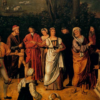Book Review: God’s Design for Man and Woman, by Andreas and Margaret Köstenberger
Andreas J. and Margaret E. Köstenberger. God’s Design for Man and Woman: A Biblical-Theological Survey. Wheaton, IL: Crossway, 2014. 380 pp. $22.99.
Defending a biblical view of gender complementarity have been a cadre of pastors and theologians like Wayne Grudem and John Piper, who led in founding the Council for Biblical Manhood and Womanhood in 1987. More recently Bruce Ware, Mary Kassian, and Owen Strachan, to name only a few, have taken up the banner. Yet, in the last three decades there has not been a comprehensive and scholarly biblical theology of manhood and womanhood.[1] Until now.
THE KOSTENBERGERS’ BIBLICAL-THEOLOGICAL SURVEY
In God’s Design for Man and Woman: A Biblical-Theological Survey, Andreas and Margaret Köstenberger have given the church an erudite and elegant defense of biblical complementarity. Written with a single voice, the married Köstenbergers are uniquely qualified to write on this subject. A professor of New Testament at Southeastern Seminary, Andreas has written numerous books on marriage, hermeneutics, and biblical theology. Likewise, Margaret is a well-respected theologian and author (see her Jesus and the Feminists). Together, they have written a book that not only advocates biblical complementarity, but that displays it as well.
At about 350 pages (including three valuable appendices), God’s Design for Man and Woman is not a short book, but neither is it esoteric or difficult to read. Following the course of biblical revelation, it moves quickly. Each chapter begins with the summary points of the chapter. The method of writing is primarily exegetical, but not overly technical. Helping readers keep up with all the names, verses, and attributes of men and women are a bevy of tables (55 in all) that classify the disparate information. And throughout the rhythmic drumbeat of gender complementarity is evident.
Chapter 1 focuses on Genesis 1–3, where God reveals his original and programmatic design for men and women. Paying close attention to the biblical text, the Köstenbergers deftly handle disputed interpretations and show God creating mankind in his image, as two genders with “different roles or functions,” not “superiority or inferiority” (23). After affirming God’s good creation, they show the effects of the fall on men and women and how God’s design is marred (relationally) but not changed (teleologically). The rest of the book then explains how God reiterates and redeems his people as men and women.
Chapter 2 surveys the Old Testament. Regarding the home, the Köstenbergers state, “leadership within the family was focused on the male head,” something they call patricentricism rather than patriarchy—the latter being a pejorative or misunderstood term (60). At the national level, the Köstenbergers comb through the kings and priests to show that Israel’s leaders were always male. Prophets, conversely, could be male or female because the role was not institutional and permanent like that priests, kings, or elders in the New Testament (65). Importantly, the Köstenbergers situate their findings into a redemptive-historical framework (71–74). This strengthens their argument by showing the continuity and discontinuity between Israel and the church, but also because it demonstrates why the Old Testament pattern of male leadership has relevance for today.
The next five chapters examine the New Testament. Broken down into chapters on the Gospels (ch. 3), Acts (ch. 4), Paul’s “First Ten Letters” (ch. 5), the Pastoral Epistles (ch. 6), and the General Epistles and Revelation, or “The Rest of the Story,” with a tip of the hat to Paul Harvey (ch. 7), the Köstenbergers prove the point: gender roles are a big deal to Jesus Christ and his bride. More than just listing biblical data, they demonstrate how the design in creation is reiterated by Christ and is relevant to his church. The Köstenbergers do not shy away from controversial passages, and every significant text is treated thoroughly (e.g., Gal 3:28; Eph 5:21; 1 Tim 2:12–15; 1 Pet 3:1–7; etc.).
The final chapter draws the threads of biblical theology into a number of practical applications. They esteem the unique differences of each sex and list numerous ways that men and women can fulfill God’s mission and purpose. Standing firmly on their biblical-theological findings, the Köstenberger’s address many issues that Christians debate. Can men stay at home? Should women serve in public office? Rightly, they recognize that Scripture offers principles for addressing such questions, more than dogmatic particulars.
In the three appendices, they complete their work by offering (1) a survey of the three waves of feminism, (2) a general discussion about hermeneutics, and (3) a specific article addressing interpretation of gender passages.
THE GOOD, THE BETTER, AND THE BEST
Everything about God’s Design for Man and Woman commends it for wide dissemination and consumption, but let me mention the three reasons why pastors and thoughtful Christians should read it.
The Good
The proven-scholarship of Andreas and Margaret Köstenberger shines again in this volume. From the exhaustive lists of names, offices, and verses that categorize their research to the careful exegesis of difficult passages, the authors have provided the church with a good foundation for men and women to think about gender. More than that, because the book is written by a man and woman, it has greater rhetorical punch in the sections calling women to work in the home (Titus 2:5) or submit to their husbands (Eph 5:22–25; 1 Pet 3:1–6).
The Better
The clarity of their writing makes the Köstenbergers book accessible to the pastor, Bible study leader, and college student alike. Before reading the whole book, I used it as a resource for preaching on elders. Any pastor preaching through any book could do the same to see how Luke or Paul or Jesus stresses biblical complementarity. Because of its clear outline and introductory points to each chapter, it provides at-a-glance biblical answers, while the rest of each chapter supplies the undergirding exegesis. For the college student bombarded with arguments against marriage and for the social construction of gender, this book will be a lifeline. While it doesn’t tackle social or ethical questions head on (15–17), it provides the necessary framework to establish a biblical worldview of manhood and womanhood.
The Best
The content of the volume is so rich because it is so biblical. Skimming the book for tables and summary points serves as an edifying entrée into Scripture’s unified message about men and women. However, for those who understand and apply the biblical-theological meat of this book, the nourishment will be transformative. In addition to arguing that God’s complementarian design for men and women is biblical, the Köstenbergers present it as beautiful (258). Sadly, advocates for egalitarian rights of women miss or distort the beauty of God’s imago Dei and the way that women’s inner beauty is meant to complement men’s holy strength. This is most evident in marriage (cf. Eph 5:22–33; 1 Pet 3:1–7), but also in the ways that men and women interact in the church and the world.
ONE MINOR QUIBBLE
Because God’s Design for Men and Women is so biblically rich, I was left wanting more. One minor quibble is that some key texts in the Old Testament were overlooked. To include them may have exceeded page requirements, but consideration of Numbers 30, Ruth, Esther, the Wisdom books (esp. Proverbs 1–9 and 31), and David’s manly instructions to Solomon in 1 Kings 2 would have added depth to the Old Testament section. Whereas the chapters on Genesis 1–3 and the New Testament take the reader into mines of gold, the single chapter on the Old Testament rakes up the nuggets while leaving other canyons unexplored. This by no means diminishes the argument of the book; it simply reminds us that when doing biblical theology we can’t say everything.
CONCLUSION
The Köstenbergers have given the church a foundational resource to understand what it means to be made in the image of God—as a man or a woman.
Since even that twofold division (male or female) is disputed by the world today, their book could not have come at a more crucial time. Indeed, it helps the church plant its feet on the solid rock of God’s Word, and it opens our eyes to behold the wisdom and wonder of God’s design.
*****
[1]Recovering Biblical Manhood and Womanhood (1991, rev. 2006) has an extensive exegetical and theological section, but these 12 chapters are not technically presented as a contiguous biblical theology of manhood and womanhood.









